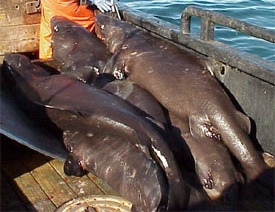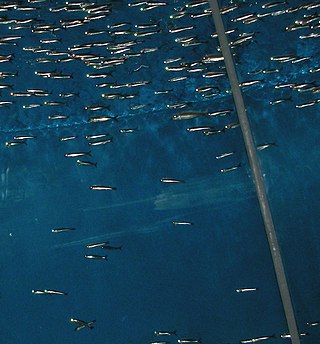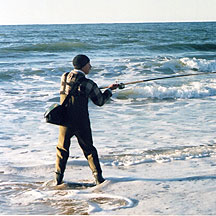Shark Bait may refer to:
- Shark baiting, a procedure to attract sharks
- Shark Bait (film), a 2006 South Korean-American computer-animated film
Shark Bait may refer to:

The great white shark, also known as the white shark, white pointer, or simply great white, is a species of large mackerel shark which can be found in the coastal surface waters of all the major oceans. It is the only known surviving species of its genus Carcharodon. The great white shark is notable for its size, with the largest preserved female specimen measuring 5.83 m (19.1 ft) in length and around 2,000 kg (4,410 lb) in weight at maturity. However, most are smaller; males measure 3.4 to 4.0 m, and females measure 4.6 to 4.9 m on average. According to a 2014 study, the lifespan of great white sharks is estimated to be as long as 70 years or more, well above previous estimates, making it one of the longest lived cartilaginous fishes currently known. According to the same study, male great white sharks take 26 years to reach sexual maturity, while the females take 33 years to be ready to produce offspring. Great white sharks can swim at speeds of 25 km/h (16 mph) for short bursts and to depths of 1,200 m (3,900 ft).

The Pacific sleeper shark is a sleeper shark of the family Somniosidae, found in the North Pacific on continental shelves and slopes in Arctic and temperate waters between latitudes 70°N and 22°N, from the surface to 2,000 metres (6,600 ft) deep. Records from southern oceans are likely misidentifications of relatives. Its length is up to 4.4 m (14 ft), although it could possibly reach lengths in excess of 7 m (23 ft).

A shark attack is an attack on a human by a shark. Every year, around 80 unprovoked attacks are reported worldwide. Despite their rarity, many people fear shark attacks after occasional serial attacks, such as the Jersey Shore shark attacks of 1916, and horror fiction and films such as the Jaws series. Out of more than 489 shark species, only three of them are responsible for a double-digit number of fatal, unprovoked attacks on humans: the great white, tiger, and bull. The oceanic whitetip has probably killed many more castaways, but these are not recorded in the statistics.

Deep Blue Sea is a 1999 American science fiction horror film directed by Renny Harlin and starring Saffron Burrows, Thomas Jane, Samuel L. Jackson, Michael Rapaport, and LL Cool J. Set in an isolated underwater facility, the film follows a team of scientists and their research on mako sharks to help fight Alzheimer's disease. The situation plunges into chaos when multiple genetically engineered sharks go on a rampage and flood the facility.
Pi or π is a mathematical constant equal to a circle's circumference divided by its diameter.

Bait fish are small-sized fish caught and used by anglers as bait to attract larger predatory fish, particularly game fish. Baitfish species are typically those that are common and breed rapidly, making them easy to catch and in abundant supply.

Sharni Vinson is an Australian-American actress and dancer. She is known for her roles in the television soap opera Home and Away, and in the films Bait 3D, Step Up 3D and You're Next.

Shark cage diving is underwater diving or snorkeling where the observer remains inside a protective cage designed to prevent sharks from making contact with the divers. Shark cage diving is used for scientific observation, underwater cinematography, and as a tourist activity. Sharks may be attracted to the vicinity of the cage by the use of bait, in a procedure known as chumming, which has attracted some controversy as it is claimed to potentially alter the natural behaviour of sharks in the vicinity of swimmers.
Bait may refer to:

Ocean Guardian is the manufacturer of devices that use Shark Shield Technology. The Ocean Guardian electronic devices create an electromagnetic field to deter shark attacks and are used by surfers, scuba divers, snorkelers, spearfishers, ocean kayak fishers, swimming areas off boats and for ocean fishing. It is considered one of the few electrical devices on the market that has performed independent trials to determine the effectiveness at deterring shark attacks, Whilst it is noted the Shark Shield Technology does not work in all situations, new modelling research from Flinders University states that the proper use of personal electronic deterrents is an effective way to prevent future deaths and injuries, it is estimated that these devices can save up to 1063 Australian lives along the coastline over the next 50 years.

Chumming is the blue water fishing practice of throwing meat-based groundbait called "chum" into the water in order to lure various marine animals to a designated fishing ground, so the target animals are more easily caught by hooking or spearing. Chums typically consist of fresh chunks of fish meat with bone and blood, the scent of which attracts predatory fish, particularly sharks, billfishes, tunas and groupers. In the past, the chum contents have also been made from "offal", the otherwise rejected or unwanted parts of slaughtered animals such as internal organs.

Shark Bait is a 2006 computer-animated adventure film. The plot revolves around Pi and his attempt to win the heart of Cordelia while dealing with a tiger shark that is terrorizing him and the reef's inhabitants.
The Reef may refer to:

Surf fishing is land-based game fishing while standing on the shoreline or wading into the surf zone. A general term, surf fishing may or may not include casting a lure or bait, and refers to all types of shore fishing – from sandy and rocky beaches, rock jetties, or even fishing piers. The terms surfcasting or beachcasting refer more specifically to surf fishing from the beach by casting into the surf at or near the shoreline. With few exceptions, surf fishing is done in saltwater. The most common misconception about surf fishing is the idea that one must cast as far out as possible in order to reach the fish. At beaches on the west coast of the United States, and in fact, at most beaches around the world, you only really need to get your bait into knee-deep water. This is referred to as surf fishing the "skinny".
A drum line is an unmanned aquatic trap used to lure and capture large sharks using baited hooks. They are typically deployed near popular swimming beaches with the intention of reducing the number of sharks in the vicinity and therefore the probability of shark attack. Drum lines are often used in association with shark nets, which results in shark mortality. However SMART drum lines can be used to move sharks, which greatly reduces shark and bycatch mortality. The use of drum lines has been successful in reducing shark attacks in the areas where they are installed. The topic of shark culling became an international controversy and sparked public demonstrations and vocal opposition, particularly from environmentalists, animal welfare advocates and ocean activists.

A bait ball, or baitball, occurs when small fish swarm in a tightly packed spherical formation about a common centre. It is a last-ditch defensive measure adopted by small schooling fish when they are threatened by predators. Small schooling fish are eaten by many types of predators, and for this reason they are called bait fish or forage fish.

Shark Night is a 2011 American horror film directed by David R. Ellis and written by Will Hayes and Jesse Studenberg. It stars Sara Paxton, Chris Carmack, Katharine McPhee, Alyssa Diaz, Dustin Milligan, and Joel David Moore. The film, which was negatively received by critics and grossed $40 million worldwide, was released in Real D 3D and Digital 3D. This was Ellis's final film before his death.
Holly Earl is an English actress. She began her career as a child actress in the ITV series Touching Evil (1997–1998). She is known for her roles in the BBC series Casualty (2010-2011) and Cuckoo (2012–2016), the ITV series Beowulf (2016), and the Channel 4 series Humans (2018).

Bait 3D is a 2012 3D horror disaster film directed by Kimble Rendall based on the screenplay by John Kim and Russell Mulcahy. It featured Sharni Vinson, Phoebe Tonkin, Xavier Samuel, Julian McMahon, Cariba Heine, Alex Russell, Lincoln Lewis, Alice Parkinson, and Dan Wyllie. The film centers around a group of people who try to escape a grocery store, submerged as a result of a freak tsunami, while being hunted by bloodthirsty great white sharks. The film was released on 20 September 2012 in Australia.